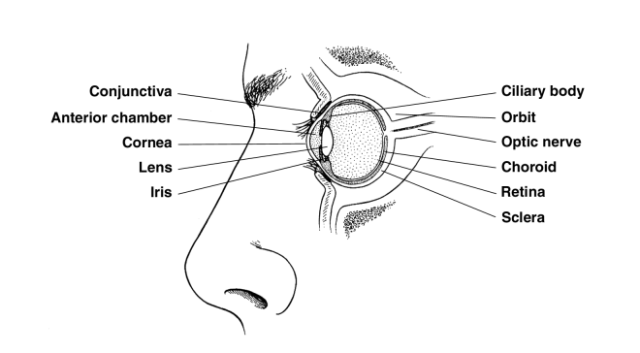lens The primary focusing structure of the EYE, located in the center at the front of the eye. The lens is transparent, convex (rounded outward on each side), round, and flexible. A thin membrane encloses the lens. Tiny muscles at the front edges of its sides, the ciliary muscles, contract to flatten the lens and relax to thicken the lens. These adjustments alter light refraction (the angle at which the lens bends lightwaves entering the eye) to accommodate near and distant vision. The most common health conditions that affect the lens are PRESBYOPIA, in which the FLEXIBILITY of the lens diminishes with aging, and CATARACT, in which protein deposits cloud the lens and obscure vision. The lens is also vulnerable to accidental injury, particularly from blunt force (such as a baseball) or puncture.
For further discussion of the lens within the context of ophthalmologic structure and function please see the overview section “The Eyes.”
See also CATARACT EXTRACTION AND LENS REPLACE- MENT; CORNEA; HYPEROPIA; MYOPIA; REFRACTIVE ERRORS; RETINA; VISION IMPAIRMENT.
mydriasis Excessive or persistent dilation of the pupil that is a symptom of ophthalmic or systemic conditions. The ophthalmologist may induce mydriasis, using topical atropine, to examine the inner EYE. Therapeutic mydriasis using atropine- based ophthalmic drops is an alternate treatment for AMBLYOPIA. Two eye conditions can cause mydriasis: GLAUCOMA and damage to the iris. In the healthy eye the iris, a muscular membrane, con- trols the opening of the pupil. INFLAMMATION of or tears in the iris affect its ability to function, which also can result in mydriasis.
Other causes of mydriasis are systemic, involving damage to NERVOUS SYSTEM structures and functions, and may include TRAUMATIC BRAIN INJURY (TBI), STROKE, and medication response such as with narcotic use, which causes the muscles to relax. Eye disorders often affect only one eye (unilateral mydriasis), whereas systemic conditions typically affect both eyes (bilateral mydriasis). PHOTOPHOBIA (sensitivity to bright light) often accompanies mydriasis as the dilated pupil cannot limit light from entering the eye. VISION IMPAIRMENT depends on the extend of the dilation; a fully dilated pupil prevents focus on near objects.
The diagnostic path begins with a basic OPH- THALMIC EXAMINATION including SLIT LAMP EXAMINATION and OPHTHALMOSCOPY, unless there is clear evidence that the mydriasis results from systemic causes. TONOMETRY, which measures the pressure within the eye (INTRAOCULAR PRESSURE), determines whether glaucoma is present. Tears of the iris are typically apparent when looking at the eye as they distort the iris (the colored portion of the eye). Inflammation of the iris (IRITIS) often reddens the eye and is apparent with ophthalmoscopy. Further diagnostic measures turn to NEUROLOGIC EXAMINA- TION. Treatment targets the causative condition.
See also EYE PAIN; NARCOTICS; TRAUMA TO THE EYE.
myopia A refractive error commonly called nearsightedness, in which the EYE has difficulty focusing on distant objects. Myopia results when the focal point of lightwaves entering the eye falls short of the RETINA, causing the images the retina registers to be blurred. The refractive error occurs because the distance from the front to the back of the eye is longer than normal. Symptoms of myopia include
• squinting when looking at distant objects
• straining to see when driving
• difficulty seeing the ball when playing baseball, tennis, and similar sports
• frequent headaches at the end of the day
CORRECTIVE LENSES (eyeglasses or contact lenses) can compensate for myopia by altering the focal point of lightwaves so it falls directly on the retina. They do so by refracting, or bending, the light- waves inward. Eye professionals denote refractive corrections in units of measure called diopters. For myopia, the expression of diopter is a negative number. REFRACTIVE SURGERY, which permanently
alters the shape of the CORNEA, provides refractive correction for mild to moderate myopia (–1 to –15 diopters). In 2004 the US Food and Drug Administration (FDA) approved an implantable contact lens to improve severe myopia (–15 to –30 diopters). Severe myopia sometimes cannot be fully corrected, resulting in VISION IMPAIRMENT with functional limitations or legal blindness. Myopia is the most common refractive error, affecting about 35 percent of adults.
See also ASTIGMATISM; HYPEROPIA; PRESBYOPIA; REFRACTIVE ERRORS.

